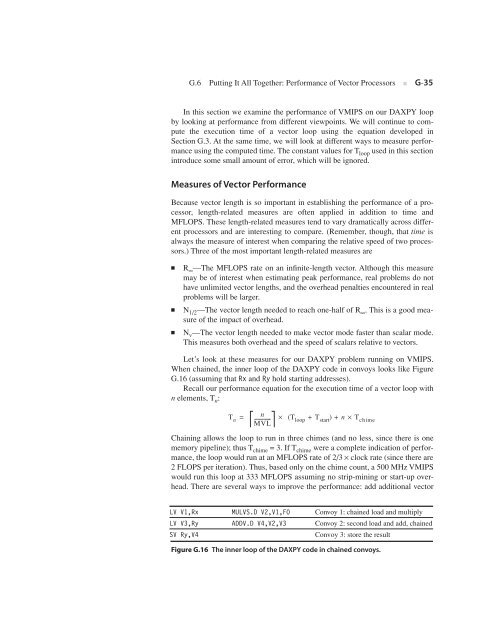Appendix G - Clemson University
Appendix G - Clemson University
Appendix G - Clemson University
Create successful ePaper yourself
Turn your PDF publications into a flip-book with our unique Google optimized e-Paper software.
G.6 Putting It All Together: Performance of Vector Processors ■ G-35<br />
In this section we examine the performance of VMIPS on our DAXPY loop<br />
by looking at performance from different viewpoints. We will continue to compute<br />
the execution time of a vector loop using the equation developed in<br />
Section G.3. At the same time, we will look at different ways to measure performance<br />
using the computed time. The constant values for T loop used in this section<br />
introduce some small amount of error, which will be ignored.<br />
Measures of Vector Performance<br />
Because vector length is so important in establishing the performance of a processor,<br />
length-related measures are often applied in addition to time and<br />
MFLOPS. These length-related measures tend to vary dramatically across different<br />
processors and are interesting to compare. (Remember, though, that time is<br />
always the measure of interest when comparing the relative speed of two processors.)<br />
Three of the most important length-related measures are<br />
■ R ∞ —The MFLOPS rate on an infinite-length vector. Although this measure<br />
may be of interest when estimating peak performance, real problems do not<br />
have unlimited vector lengths, and the overhead penalties encountered in real<br />
problems will be larger.<br />
■ N1/2 —The vector length needed to reach one-half of R∞ . This is a good measure<br />
of the impact of overhead.<br />
■ Nv —The vector length needed to make vector mode faster than scalar mode.<br />
This measures both overhead and the speed of scalars relative to vectors.<br />
Let’s look at these measures for our DAXPY problem running on VMIPS.<br />
When chained, the inner loop of the DAXPY code in convoys looks like Figure<br />
G.16 (assuming that Rx and Ry hold starting addresses).<br />
Recall our performance equation for the execution time of a vector loop with<br />
n elements, T n :<br />
Tn =<br />
n<br />
------------- × ( Tloop + Tstart) + n × Tchime MVL<br />
Chaining allows the loop to run in three chimes (and no less, since there is one<br />
memory pipeline); thus T chime = 3. If T chime were a complete indication of performance,<br />
the loop would run at an MFLOPS rate of 2/3 × clock rate (since there are<br />
2 FLOPS per iteration). Thus, based only on the chime count, a 500 MHz VMIPS<br />
would run this loop at 333 MFLOPS assuming no strip-mining or start-up overhead.<br />
There are several ways to improve the performance: add additional vector<br />
LV V1,Rx MULVS.D V2,V1,F0 Convoy 1: chained load and multiply<br />
LV V3,Ry ADDV.D V4,V2,V3 Convoy 2: second load and add, chained<br />
SV Ry,V4 Convoy 3: store the result<br />
Figure G.16 The inner loop of the DAXPY code in chained convoys.

















